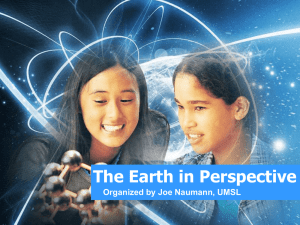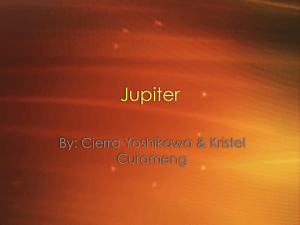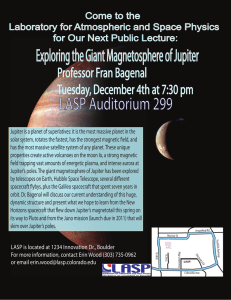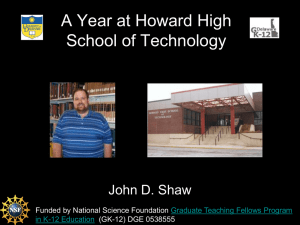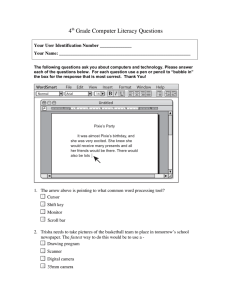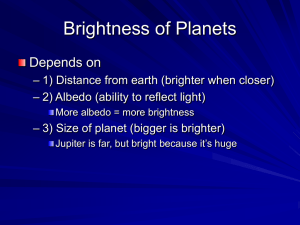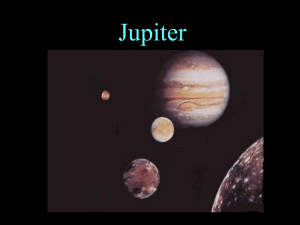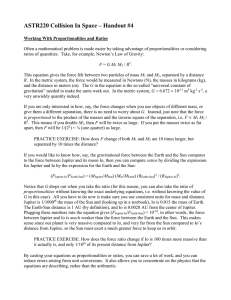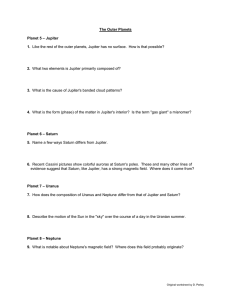—Roman God of Sky Jupiter —King of the Gods and Thunder
advertisement
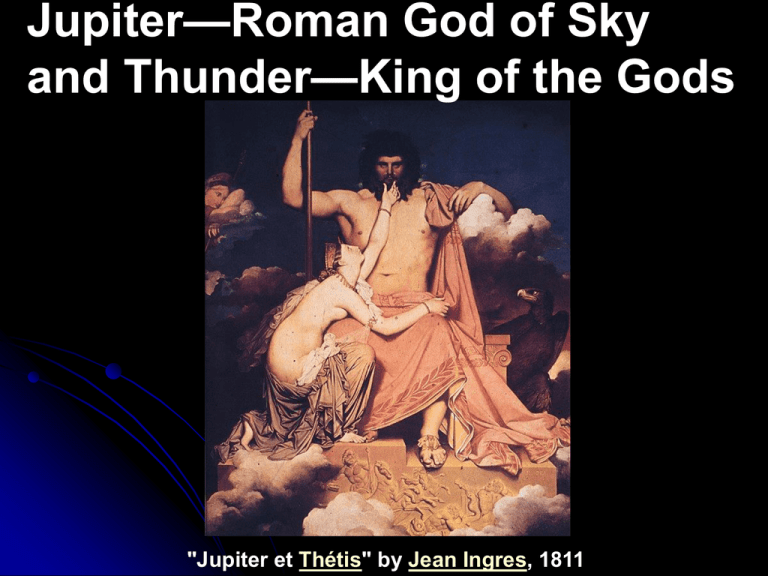
Jupiter—Roman God of Sky and Thunder—King of the Gods "Jupiter et Thétis" by Jean Ingres, 1811 Jupiter ─ Coming Up What observations from Earth reveal about Jupiter Jupiter’s composition Jupiter’s structure How Jupiter rotates differently than terrestrial planets The nature of Jupiter’s immense storms How Jupiter’s internal heat drives activity in its atmosphere The effect of ‘Coriolis forces’ on Jupiter’s atmosphere What the Galileo space probe revealed about Jupiter’s atmosphere How Jupiter’s intense magnetic field is produced by an exotic form of hydrogen Jupiter—As Seen From Earth Jupiter • From Earth (2.6 m Nordic Telescope, Canary Islands) • Jupiter and Io • Voyager 2, 1979 • Ganymede’s shadow • Io What is the physical appearance of Jupiter as seen from Earth or a spacecraft? A.a series of dark belts and light zones parallel to its equator B.a uniform bluish color with a high-level haze C.v-shaped cloud forms around its equator, indicative of rapid winds D.uniform red-colored dust clouds over a heavily cratered surface Google: "The Man in the Green Hat.“ The Coriolis Force Named after the French Scientist Gaspard Gustave Coriolis Because of the Earth’s rotation, free moving objects … • deflected to the right in the Northern Hemisphere • to the left in the Southern Hemisphere • Depends on an object’s speed—higher speed means stronger Coriolis Force. A Pressure Gradient North Latitude H Pressure (mb) 1017 1015 • A pressure gradient causes wind to blow straight from High P to Low P and accelerate as it goes 1013 1011 1009 Equator 1007 L Pressure, Coriolis Force, Friction North Latitude H Pressure (mb) 1017 • Wind doesn’t blow straight from High to Low … curves to the right of straight line. 1015 • H and L don’t last forever without energy source … why? 1011 1013 1009 Equator Rotation of Earth 1007 L Atmospheric Circulation on Slowly Rotating Earth What are the major factors that cause winds to flow from east to west and west to east in alternating bands that encircle the Earth? A. Carbon dioxide in Earth’s atmosphere. B. Earth has an extensive ring system. C. The gulf stream in the Atlantic and El Nino in the Pacific. D. Atmospheric convection and rotation of the Earth. Curved Flow around High and Low Cyclonic Flow Anticyclonic Flow Actual flow around pressure systems are never this regular . Cyclones and Anti–Cyclones Around a surface low pressure center, net inward transport of air causes a convergence … air rises in the center. Around a surface high pressure center, net outward transport of air causes a divergence … air falls in the center. Anti–Cyclones Anticyclones : high pressures with nearly circular isobars. • Air descends toward surface due to convergence aloft. • As air nears surface it is forced outward (divergence). • Coriolis effect bends air to the right of its path creating a clockwise rotation. • Under an anticyclone, air is descending, forming an area of higher pressure at the surface. • Cloud formation is inhibited, so the weather is usually settled with only small amounts of cloud cover. Cyclone Cyclones: Low pressures that exhibit nearly circular isobars. • As air enters low pressure from all directions, Coriolis effect bends wind direction to the right of its path. • This creates counterclockwise rotation around the low and convergence near the center. • As air collides near center it is forced aloft where divergence takes air away from the center. • Upper-level divergence maintains low pressure. • Rising air cools,condenses helps cloud formation, so weather associated with cyclone is cloudy and wet. Cassini 4-image Composite of Jupiter (2000 Flyby) Solid rotation typifies the terrestrial planets: Every part of the object takes exactly the same time to complete one rotation. Differential rotation typifies Jupiter: Particles at different locations in the fluid take different lengths of time to complete one rotation. What causes Jupiter's belts and zones? A. Electrical conduction in Jupiter’s liquid metallic hydrogen layer that causes electrons to swirl around the planet B. The “sweeping” of Jupiter's clouds through magnetic field lines from Jupiter's magnetosphere C. Convection in Jupiter’s atmosphere, stretched into bands by strong Coriolis forces due to Jupiter's rapid rotation D. Electric force fields set up by an advanced civilization set up to protect Jupiter from alien attack Zones appear dark because their high-altitude clouds are cold. Belts appear bright because we see to warmer depths of the atmosphere. The Great Red Spot (a region of cool, high-altitude clouds) appears dark. Infrared Image Pioneer 11—December 1974 Note the Great Red Spot and Surroundings Voyager 2—July 1979 HST—February 1995 Winds on the north side of the Great Red Spot flow westward. Turbulence downwind of the Great Red Spot Winds within the Great Red Spot circulate counterclockwise. 20,000 km Winds on the south side of the Great Red Spot flow eastward. Earth’s Diameter The Great Red Spot most probably is ________. A. clouds of dust-laden gas rising up over the top of a massive mountain or a volcano on the planet's surface B. a large, long-lived, high-pressure storm in Jupiter's atmosphere C. the colored polar ice cap of Jupiter D. a large, red zit that appeared on Jupiter’s nose after coupling with Juno Galileo Probe Enters Jupiter Jupiter’s Magnetosphere Strongest radio emission from electrons trapped in current sheet The material in the interior of Jupiter thought to be responsible for its powerful magnetic field is_____. A. molten iron and nickel B. liquid metallic hydrogen C. gasses of NH3 (ammonia), CH4 (methane) and H2O (water vapor) D. solid magnetic iron Jupiter’s Main Ring Key Ideas Composition and Structure: Jupiter’s mass is 318 ME and its volume is over 1000 Earths. Overall composition–86% hydrogen, 12% helium, and 2% other elements by numbers. Jupiter probably has a rocky core several times more massive than the Earth. The core is surrounded by a layer of liquid “ices” (water, ammonia, methane, and associated compounds). The “ices” are surrounded by a layer of helium and liquid metallic hydrogen and an outermost layer composed primarily of ordinary hydrogen and helium. Key Ideas Jupiter rotates so rapidly that it is noticeably “flattened.” Its interior rotation is revealed by variations in its radio emission. Jupiter emits about 2 x more energy than it receives from the Sun—probably it is still cooling. Key Ideas Atmosphere: The visible “surface” of Jupiter is actually the tops of its clouds. The rapid rotation of the planets twists the clouds into dark belts and light zones that run parallel to the equator. Strong zonal winds run along the belts and zones. The outer layers of the atmosphere show differential rotation—the equatorial regions rotate slightly faster than the polar regions. The polar rotation rate is nearly the same as the internal rotation rate. The colored ovals visible in the Jovian atmosphere represent gigantic storms. Some, such as the Great Red Spot, are quite stable and persist for many years. Key Ideas Clouds: There are presumed to be three cloud layers in Jupiter’s atmosphere made of NH3, NH4SH and H2O ices, which are all white crystals. The reasons for the distinctive colors of these different layers are not yet known, but probably are caused by long chain molecules containing sulfur and phosphorus. Key Ideas Magnetic Field and Magnetosphere: Jupiter has a strong magnetic field created by currents in the metallic hydrogen layer. Its huge magnetosphere contains a vast current sheet of electrically charged particles. Charged particles in the densest portions of Jupiter’s magnetosphere emit synchrotron radiation at radio wavelengths. The Jovian magnetosphere encloses a low-density plasma of charged particles. The magnetosphere exists in a delicate balance between pressures from the plasma and from the solar wind. When this balance is disturbed, the size of the magnetosphere fluctuates drastically.
